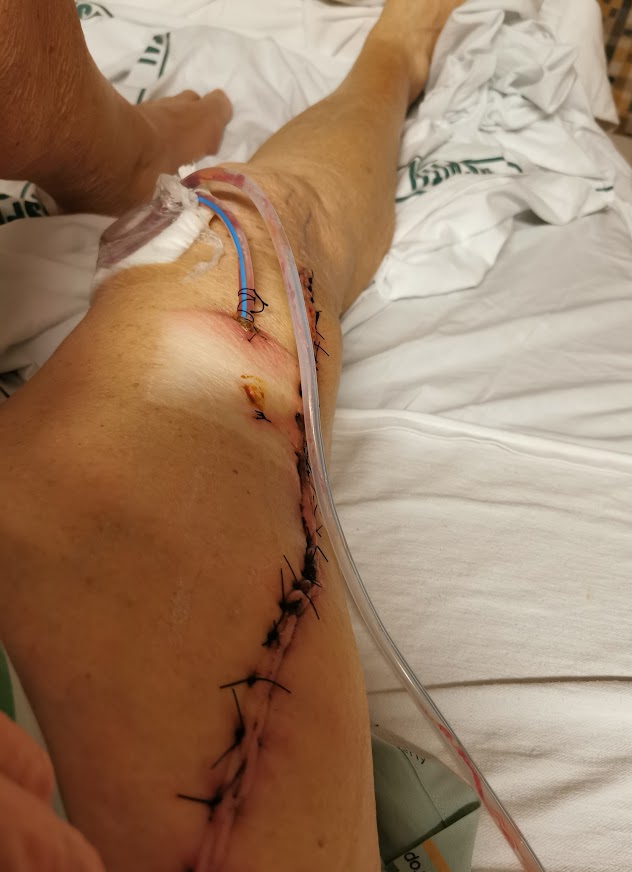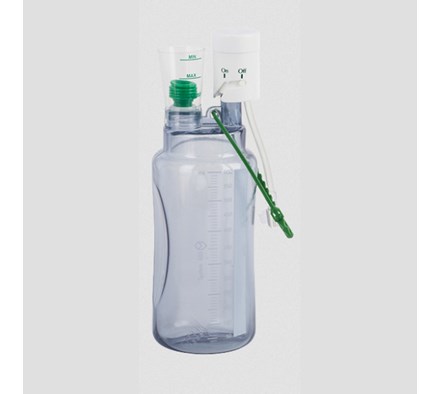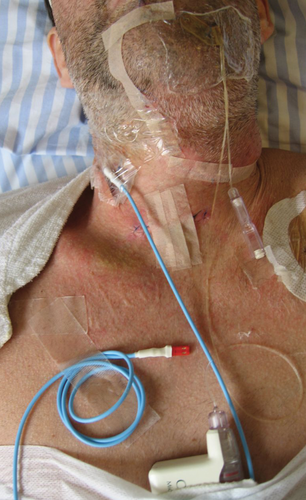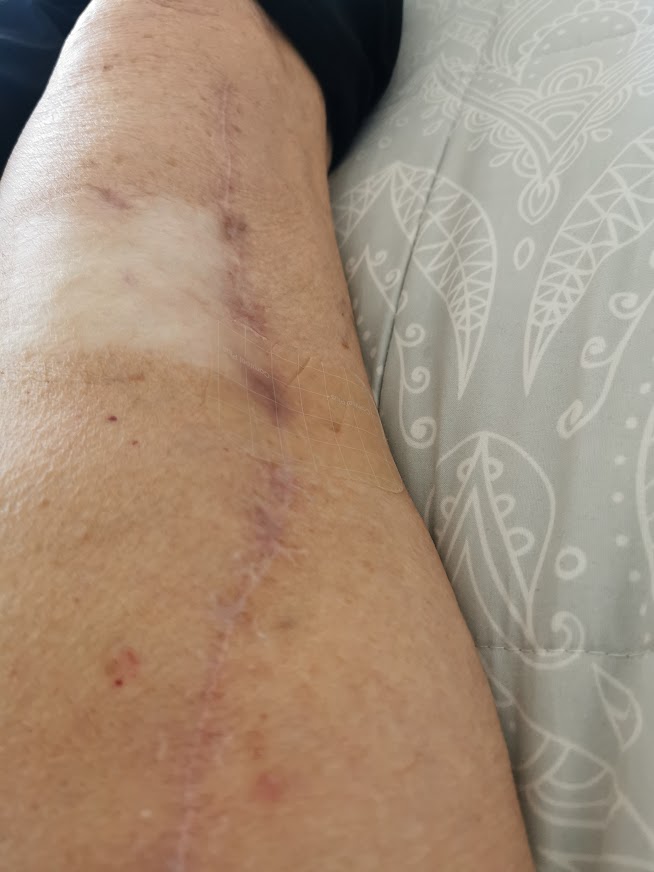
My third free flap
My previous “free flaps” for HNC have been on my forearms but this time I had an antero-lateral thigh flap. That means the tissue was taken from the front of the side of my thigh. With the accompanying blood vessels the tissue removal has led to a scar that reaches from my groin almost to my knee. About 8 centimeters up my scar is a dip in my thigh and the scar thickens. There’s a ten centimeter depression where the tissue – skin, muscle, fat, fascia (I don’t know) – was removed to patch a big hole in the left side of my throat. The rest of the scar looks normal and will settle to just a thin line.
The hospital experience
The first thing I noticed when I was allowed to get up out of bed on about Day 3 was that the thigh was very tender. I was glad for my strong arms which meant I could push myself up from a chair to a standing position. It was made harder by the fact that my left knee has bad osteo. I managed though and the thigh was not really a major problem. It looked gory with its many stitches and two drains, the second one of which was slow to stop draining. I really had no problem with it until I went home with that stubborn drain and got the inside of the thigh infected. When they pulled the drain out, pus came out too.
I think the thigh is a small price to pay for the life saving op and if it hadn’t become infected, healing would have been plain sailing. Although I must say the drains were a pain in the proverbial. I wish I had learned more about the despised drains which have some sort of vacuum to suck out excess fluid and blood and enable the would to heal faster. If I had learnt more about the attachments and how the fluid is measured I would have looked after the drain better when I came home. I think I could have taken a more detached interest in all the drains while I was in hospital. Knowledge is power.

Around the time of the infection, the thigh muscle (quad) was very sore, I needed opiates for the pain for a short time and it was very hard to get into the car. With antibiotics, however, it healed slowly and now 47 days after surgery, it is almost back to normal. Almost. After an outing today it feels a bit tight. The hollowed out piece of the thigh does not look too bad though.
Checking the flap for viability
How are these flaps from paddles of tissue and blood vessels attached to the mouth and throat? I’ve never really delved into it too deeply because it’s hard to look at your own body dispassionately. I know that the flap is stitched into place and blood vessels are joined by “microvascular surgery”. After the surgery the blood vessels are checked for function via a Doppler device (blood flow monitor) that is activated by wires attached to the back of the head. I have no idea if the wires were implanted like the picture below but there was some sort of sophisticated connection.
During the previous surgeries – two forearm flaps – I felt very nervous every time they put a probe in my mouth but this time with better tech it was less worrisome. They turned something on and soon you could hear the pulse of the blood through the newly attached vessels and even see them on a bedside screen. Flaps can fail (very rare) and need to be fixed so I have been three times lucky.

The feeling of the flap in the final site
The miracle of this surgery is that the leg tissue sewn into my throat doesn’t bother me at all. I can’t see it or feel it and my swallowing, although not 100%, is the least of my worries.
Getting the stitches out
This is another thing that patients can find daunting, especially when there are clips too which release tension they are pulled out and can ping a bit. I have a couple of bits of advice. Form some sort of relationship with the nurse who is doing it. Ask them to go slow. Have some sort of mental distraction like going through the alphabet with countries in the world or reciting a well known song under your breath or even just counting. It’s never as bad as one expects. A relief when it’s over because the removal of stitches means you are one big step closer to going home.
Some ongoing problems
As I update this story though, I have to admit that 8/9 months later one of the spots in the depression of my wound hasn’t healed properly. After lots of attempts with a range of dressings I now conclude it is because of my clothes rubbing on it. I do tend to wear stretchy trousers. A transparent silicone hydrocolloid dressing seems to be doing the trick.

Other patients in our group have had some problems with pain in the leg or like me a slow to heal spot.
And in conclusion
At 75 I don’t grieve much for my cut up body. My strong legs were the best part of me so it’s a bit sad to lose part of one of them and also to have big scars where the nice firm skin of the inner wrist used to be.
I don’t know how other people feel about their flaps and skin grafts. Our bodies have been under extreme assault.
But I can view it through a reasonably positive lens. The rest of my body came to the rescue of my mouth and throat.